So I spent the night in Krusevo and woke up with a cold. Huh? I had no symptoms prior to when I woke up, but I most definitely had a sore throat and was rather hoarse. When I found Jane at breakfast and told him I think I had caught a cold, he immediately sent Dean to the pharmacy for some local medicine. When he returned, I drank a tea recommended for colds and the sore throat went away. In fact, I actually felt just fine. No idea what it was, but I was not going to spend any time worrying about it since whatever it was seemed to be gone.
Anyway, Jane had recommended that we spend about an hour in Krusevo visiting a couple very important sites in Macedonian history. Now Krusevo was, at one time, a seat of a major uprising against the the Ottoman Empire. In 1903, freedom fighters in Krusevo led the Ilinden Uprising with the goal to break away from the Ottoman Empire and declare an independent Krusevo state. Initially, the freedom fighters fought back the Ottoman soldiers, but it wasn’t long before Turkey sent reinforcement and began to take back Krusevo. The last stand was by Pitu Guli and his platoon who, surrounded by Turk fighters, decided it was better to commit suicide than be taken alive. Those who were captured were killed by the Turks and their bodies left hanging from trees as a warning to other Macedonians to not cross the Turks. In addition, the Turks burned Krusevo to the ground.

So with this backdrop, we first visited the monument to Pitu Guli called Meckin Kamen, which is the monument that symbolizes the last and desperate attempts of the platoon led by Pitu Guli to defend the Republic of Krushevo. The monument was a huge stone carving of a man hurling a stone with the words carved into the stone “Death or Freedom”. Each year the last stand is celebrated throughout Macedonia on August 2. And while Jane noted that Macedonia is one of the few countries to actually celebrate a loss, the intent of the celebration is to commemorate the spirit of Macedonia.

Now not far from this site is a world renouned paragliding site set amongst the pine trees. Apparently the winds allow for perfect paragliding conditions with truly spectacular views to the valley below. In fact, the site is so popular that countries from around the world use the site for training purposes and recently the world championships were held a the site.
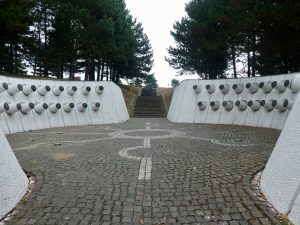
After a quick look at the site, we drove to the opposite side of the Krusevo to the 1903 Ilinden Uprising monument, which from a distance, looked like a giant white spaceship. The walk to the monument took us past various sculptures including three “chains” that signified the oppression by the Turks, a broken chain that signified the freedom won by the wars, a crypt carved with the name of important fighters and events, and a “classroom” with wonderful colours signifying the learning that continues for the citizens of Macedonia.
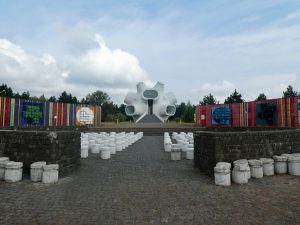
The main portion of the monument includes the tomb of Nikola Karev, the first President of independent Krusevo, and windows representing significant events in the uprising. The guide at the site was incredibly informative and explained the meaning of the windows each dedicated to an important event in the uprising and the eventual freedom from the Ottoman empire.
We made one more stop in Krusevo to buy lokum, a local specialty similar to Turkish delight. The drive took us through the narrow winding streets of Krusevo before we stopped at a little family owned shop that was apparently THE place for lokum. We bought three boxes and got back in the van. I immediately opened one box and tried a rectangular piece of the candy. After a bite, I concluded that lokum was sweeter and softer that Turkish delight and cut in much larger pieces, but otherwise was covered in powdered sugar just like Turkish Delight and certainly had the same jelly-like texture. It was super sweet, but boy was it good!
We finally left Krusevo and headed to the Povardarie region in the north central portion of Macedonia, which is the primary wine growing region in Macedonia. And while we were going to taste some wines in the afternoon, our first stop in the wine region was to be at the ancient ruins of Stobi.

Now Stobi was constructed during Hellenic period some time between the 2nd and 3rd century B.C. In 167 B.C., the Romans invaded and took over the city. Under the Romans, the city became a integral trading center. And when Christianity became the official religion of the Romans in the 4th century, the oldest known Episcopalian basilica was constructed at Stobi. Over the centuries, earthquakes and invaders destroyed the city, which was rebuilt at least twice. The city was eventually abandoned in the 6th century after yet another devastating earthquake.
Once we reached Stobi local guide, Vana, provided us with a tour of the site. Now the site is massive and only about 20% of the site has been excavated and not a single tree in sight. At one time, the city had been surrounded by a rock wall with the wealthy living within the walls of Stobi and the plebes and slaves living outside the walls. Now, only remnants of the wall remains.
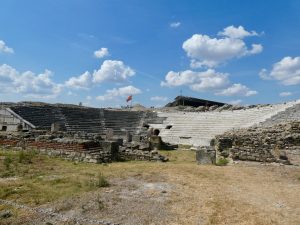
We started the tour with a visit to the theater, which dates to the 2nd century. In its heyday, the theater could hold 7600 people, but was now undergoing a massive reconstruction effort to bring it back to its former glory. When the Romans took over Stobi, the theater was used for gladiator fights, but eventually the Christians began to dismantle the theater to use the stones for other buildings in Stobi. (In fact, stones used from the theater were visible at other sites in Stobi as evidenced by names etched into the stones, which were a form of “season ticket holder” identification at the theater.) Today, the theater is still used for plays, although I gotta believe that it would be incredibly hot with no trees for shade.
We then walked up the hill and climbed onto a platform to see the remains of a basilica housed un a protective roof. The basilica dates to the 4th century and is considered one of the oldest churches in the world. The basilica included a massive mosaic in the interior as well as a mosaic at the entrance.

Across from the basilica was the 4th century baptismal fountain, which was surrounded by a completely intact mosaic. Apparently the mosaic had been covered with sand and dirt for centuries resulting in a perfectly preserved mosaic. It was beautiful, but now that it was uncovered it was subject to deterioration. Fortunately, Vana advised me that they have plans to erect a protective roof over the ruins much like they had done for the basilica.

We moved on to the Semi-Circle Square, which had one column still standing and then walked along the remains of what was once the main road in Stobi leading in one direction to the city of Heraclea Lyncestis, which I had visited the day before, and in the other direction towards the main part of the city. The remnants of stone that once covered the entire road was visible in both directions.
Next up was the first home we encountered, Domus Fulonica. There was not much remaining of the residence, but you could still see parts of the stone walls and one pillar.

And adjacent to the first home, was the Theodosian Palace dating to the 4th century. These ruins were spectacular with magnificent mosaics surrounding a pillared courtyard. It is believed that this was the palace of Emperor Theodosius I that was used by him when he visited Stobi.

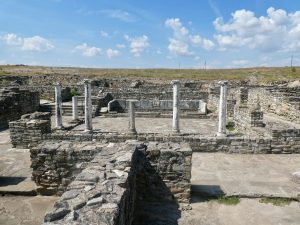

Across from the palace was the House of Peristeria, yet an other residence dating to the 4th century where the open courtyard and mosaic floor were still well preserved. This residence was perhaps the most elaborate in Stobi (other than the palace), with lots of columns lining another courtyard and stone wall containing a really unique carving that is believed to be a headstone depicting departed family members. What I found particularly interesting is the headstone included the carving of a small child. I would love to know the story behind that.
We continued down the road to the first of two baths. Romans were big on cleaning and enjoying spas so you will always see baths amongst Roman ruins. Now this bath was the mens’ bath, which was apparently identified by remains found in the site. The baths were in very good condition and included the cleaning area, heated floor and the wet and dry spas. The Romans developed ingenious systems to move water and sewer through the cities and the ceramic pipes lined with lead used by the Romans were visible here.

Now as luck would have it, the Romans did not know that lead was poisonous so most of the residents of Stobi died young. When the bodies in the graves were exhumed, high levels of lead were discovered in the bones. Yikes. Not a good way to go.
Anyway, the ruins of what was billed at the “larger” spa were in spectacular condition. Across from the baths were storage facilities where massive clay vessels had been uncovered in near perfect condition.


We wandered past the storage area to the next site the House of Polycharmous. Now apart from the fact that the house contained gorgeous mosaics and a number of intact pillars surrounding the courtyard, the real star was the Jewish Synagogue that was constructed as part of the residence. It is believed to be the oldest synagogue outside of Israel. There were still a number of pillars standing around the worship area.

Next to the House of Polycharmous was what was believed to be the womens’ baths. Apparently there was jewelry and oils found on the site leading people to believe it was the womens’ bath. And as is typical, the womens’ bath was far smaller than the mens’ bath. I envisioned lines to get in just like women experience today to get into a public bathroom. I commented on this to Varna and she nodded and laughed. Apparently, some things never change!

The last sight we visited on the backside of the city was the forum and library, which was probably my favourite building. It was clearly older than the other ruins with the site believed to date the the 1st century or possibly later. And the way they knew this was older ruins was the depth at which the ruins were discovered. Typically older ruins are found deeper in the ground and these ruins were far deeper than other ruins at the site. In fact, it was believed the original library was destroyed by fire with new buildings erected on top of the site. Despite the fire, the mosaic floor was still in good shape as was a number of brick arches that made up the forum at the opposite end of the structure.
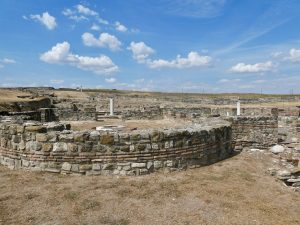
By now we had been wandering around the site for almost an hour without the benefit of shade. It was very hot and I could tell that Varna was starting to melt. Me. I could have wandered around for hours. Nevertheless, we started our walk towards the entrance while taking in two more sites. The first was the casino. Yep. A gambling establishment. And they know this because ancient dice, tiny blocks believed to be ancient chips and tables led researchers to the conclusion it was a casino. What really cracked me up is that they discovered an old tunnel that led from the casino to the Basilica up the hill. You have to wonder what was up with those religious folks.

The last site we visited was the Temple of Isis. There was not much left beyond the platform and it was believed that when the Christians took over Stobi, the pagan temple was destroyed.
The visit to Stobi had been absolutely wonderful, albeit rather hot. After thanking Vana for the tour, it was time to head to lunch. Now this was going to be a special lunch. We were heading to Kavadartsi for a wine tasting at the winery/home of George Naumchev, a small wine producer. The drive took us back through Prilep, which we had visited the day before, and past the tobacco fields. Eventually the tobacco fields gave way to rolling hills, peach trees and vineyards. As we drove, we frequently found ourselves stuck behind a tractor hauling grapes from the vineyards. It was, after all, harvest season.
 We reached the little town of Kavadartsi, which is in the Tikves wine region in Macedonia, and wound through the narrow streets to reach George’s home. We pulled up and were welcomed like old friends. Jane apparently met George last year and has started working with him to host tourists for wine tastings.
We reached the little town of Kavadartsi, which is in the Tikves wine region in Macedonia, and wound through the narrow streets to reach George’s home. We pulled up and were welcomed like old friends. Jane apparently met George last year and has started working with him to host tourists for wine tastings.

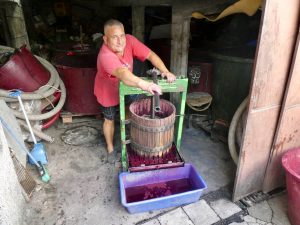
George has been producing wines for 20 years under the name “Naumcevi”. He first gave us a tour of his little winery, which occupies the lower level of his home as well as his garage. In one room were large vats in which pressed grapes were fermenting. In another room, George had batches of wine ready to bottle. In the garage, we met one of George’s employees who was hand pressing grapes. Yep. That’s right. All of George’s wines are the result of hand pressed grapes. George sources grapes from local vineyard and has a staff use old hand presses to squeeze the juices out of the grapes. The fellow we met usually hand presses between 10 and 18 barrels of grapes per day. Now THAT is a workout.
After the tour, we went back to the courtyard where George had a lovely table set ready for us to begin our tasting. George first brought out a massive tray of meze including cheese, olives and meats along with bread and a jar of THE best ajvar I had on this entire trip. George’s wife made the ajvar with extra eggplant and some spicy peppers. It was absolutely incredible.


In addition, and because Dean was driving and was not going to drink wine, George brought out a large bottle of homemade grape juice. I ended up drinking a glass and can tell you I will never drink Welches again!
After the food was brought out, we began the wine tasting with two whites, Temjanica and Chardonnay followed by a Sanusina, a blush wine. The wines were a really good quality. As we sat and enjoyed the wines and the meze, George described the wine process and his market for the wines. We also talked about each of the wines we were tasting. And I will say that this was more than a tasting because George’s pours were rather generous to say the least.
And as we were sitting there, George picked a couple of the cherry tomatoes from his vines in the little garden surrounding the courtyard and snagged a couple basil leaves and had me test his home grown veggies. As you can imagine, the homegrown tomatoes with basil were delicious..
Anyway, after the whites, George brought out three carafes of his red wines. First up was the varanet, a local grape that is massively popular in Macedonia, followed by a merlot/cab blend with the final wine being a cab. The reds were bold and incredibly good. Major “legs” as they say.

So after the wines, George took us upstairs to his cognac room and poured us some of his homemade cognac. George can’t yet sell the cognac because he is waiting for his license, but I can tell you that when he does acquire the license, the cognac will sell out fast. The cognac was a lovely coppery gold colour with a smooth buttery taste. It was very, very good.
We wandered back to the courtyard and drank the cognac while we continued to talk about tourism in Macedonia. And just when I thought we were done, George brought out three of his liqueurs made by his wife: a walnut liqueur with a dark brown colour and was off the charts tasty; a berry flavored liqueur that was deep red and very sweet; and a cherry liqueur which I did not try.
By now I was close to a state of nirvana. The food, wine and conversation in the lovely little courtyard was an experience most tourists would never have. Instead, most were down the road at the large commercial winery tasting good wines in an atmosphere they can find at home. This was as local and authentic as it comes.

And when I thought it could not get any better, George presented me with a jar of his wife’s ajar to take home with me. It was a gesture that left me speechless. It was incredibly kind, and I was thrilled to take the prized jar home.
The day had been another off the charts day. After multiple thank yous, we unfortunately had to say goodbye to George. We left his home and drove a few short miles to a Popova Kuala Winery where we would be spending the night amongst the vineyards and eating a 5 course dinner with wine pairings.

I was stuffed and could barely think about food so we decided to wait until nine to eat. When I finally did sit down to eat, I was till not hungry. We had salad, trout, pork and beef, cheese and finally dessert. What little food I did eat was delicious and wines were very good.
I finally said good night to the guys. Tomorrow they would be driving me to my next country: Albania. My fabulous time in Macedonia had come to an end. While my waistline might be happy about that, I would certainly be sad to leave the wonderful people, sites, food and hospitality this off the radar country has to offer. I will always be grateful to Jane, Dean and Macedonia Experience for providing me with an incredible trip. Nostrovia!
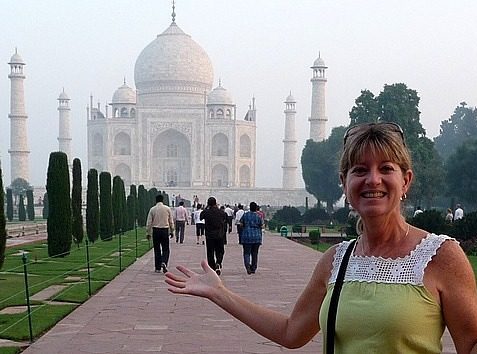
What a beautiful Country! How fortunate you are to have such a great driver and guide. Looking forward to seeing Albania through your eyes!